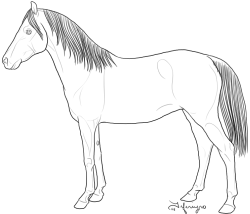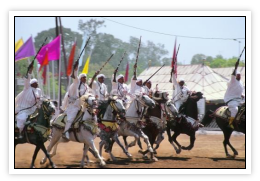|
 BY ORIYANA
BY ORIYANA
Wait, what’s that? You’ve
never heard of the Tibetan Mastiff? Well if
you’ve ever seen the B-horror movie “Man’s Best Friend” you have seen a
Tibetan Mastiff, but may not have recognized it an actual purebred dog.
I know my first look gave me the impression of a cross breed, or mutt,
but when I saw the puppy at the end, I knew I had to find out what
breed this was, and so began my obsession. No, Tibetans aren’t
genetically engineered, they can’t climb trees, swallow cats whole, or
urinate acid (that’s just asking for trouble during housebreaking
anyway).
The TM is often described as
being intelligent to a fault. Originally
bred as a guardian dog, it was developed to work apart from rather than
with man, making it independent and headstrong. This nature, combined
with it’s large size make it a breed not suitable for novice dog
owners. As with any large breed, obedience training is a must, and
should always be done by the owner. TM’s generally get along with other
animals when introduced at a young age. They are described has having
endless patience, especially when it comes to children, and will
generally accept new people that you accept, provided they have been
well socialized with people from a young age. As a flock guardian breed
they have an inherent protective nature, and should be shown the limits
of their territory frequently and from a young age. An electric fence
should never be used with a TM as they have a innate desire to explore
and a high pain tolerance.
Because the Tibetan Mastiff
is a primitive “natural” breed, it has few
if any specific health concerns. Health problems occasionally seen
within this breed are hypothyroidism, entropion or ectropion, skin
problems including allergies, low immune system including demodex,
missing teeth, malocclusion (overbite or underbite), cardiac problems,
epilepsy, progressive retinal atrophy (PRA), cataract, and small ear
canals with a tendency for infection.. Even Hip Dysplasia which often
plagues large dog breeds is rarely seen in the Tibetan Mastiff, most
likely due in part to the fact that TM’s are built lighter in the rear
than many other larger breeds, and the fact that as they were bred for
working in the mountains unsound dogs did not often survive to
reproduce. A former potential threat to the TM was CIDN (Canine
Inherited Demyelinative Neuropathy), a hereditary peripheral nerve
disorder. The disease seemed only to affect one line of TM’s and there
are currently no CIDN affected puppies being reported throughout the
world.
The Tibetan Mastiff requires an average amount of exercise, and a lot
less grooming than their coat would suggest. A good brushing several
times a week is recommended and since this breed has no doggy odor, it
really does not need to be bathed all that often. Their coat has been
described as weather-resistant, shedding only once a year (females may
blow their coat an additional time after giving birth). They can range
from 100-200lbs, and 25-31inches in height. Their average life
expectancy is 10-14 years. Females come into heat only once a year, as
opposed to the more common twice a year of “man-made” breeds. As of
January 1st, 2007, the Tibetan Mastiff was added to the working group,
and can now compete in all AKC and CKC competitions. So maybe one day
you will see me with my gorgeous dogs, strutting around the show ring,
and you will be able to say, there goes a Tibetan Mastiff.

BY ALABAMA
But don’t let size fool you.
Mother Nature has imparted on this
tiny animal an intelligence and determination shared by that of their
cousin, the mongoose. They live and die by their family. These punks
living on the street don’t have a thing on the meerkat gang. They will
fight other meerkats to the death to keep control of their territory or
to protect their family from outsiders. Ever heard of a mob of people?
Well that descriptor has been applied to the meerkat way of fighting.
There is no one on one bluffing or display dancing or drive by attacks.
They gang up and rush their targets.
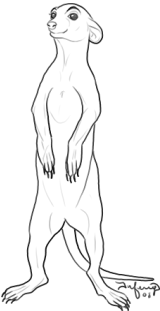 Their size makes living
together and foraging together a natural
defense against their predators, which can be many and come from all
points. The Martial Eagle, with a wing span of six foot, and other
birds of prey attack from the sky. Primary defense from these would be
diners is the meerkat’s outstanding vision and the habit of posting
sentries. With dark bands around their eyes, they can look directly
into the sun and see a bird. From the ground, the meerkat must watch
for predatory cats and Jackals. However, against these land bound foes,
the meerkats have learned to put their fighting techniques to another
use. It has been known for a gang of meerkats to mob a jackal, chasing
this predator, that can be three times their size, away. This strategy
is also used against the poisonous snakes that inhabit their home turf
and attempt to prey on them and their young. They don’t try to kill
their attackers only confuse them to the point of giving up and going
away. They always leave an avenue of escape and use all their grit and
guts to feign attack from every other side.
Their size makes living
together and foraging together a natural
defense against their predators, which can be many and come from all
points. The Martial Eagle, with a wing span of six foot, and other
birds of prey attack from the sky. Primary defense from these would be
diners is the meerkat’s outstanding vision and the habit of posting
sentries. With dark bands around their eyes, they can look directly
into the sun and see a bird. From the ground, the meerkat must watch
for predatory cats and Jackals. However, against these land bound foes,
the meerkats have learned to put their fighting techniques to another
use. It has been known for a gang of meerkats to mob a jackal, chasing
this predator, that can be three times their size, away. This strategy
is also used against the poisonous snakes that inhabit their home turf
and attempt to prey on them and their young. They don’t try to kill
their attackers only confuse them to the point of giving up and going
away. They always leave an avenue of escape and use all their grit and
guts to feign attack from every other side.
The final threat to meerkat
existence is the weather. Because they
are so small, their metabolism is faster than that of a human, meaning
they expend energy more quickly. Cold and heat both pose a danger to
the tiny individual. But, nature hasn’t forgot about this either. The
coat of the meerkat possesses insulating abilities. Against extremes in
temperature, the fur is “puffed out” creating a buffer between their
bodies and the external air. The skin on their bellies, covered by a
thin layer of hair, is black, acting as a sort of solar panel to absorb
heat from the sun. When it’s hot, they adopt a tactic similar to that
of our best friend, the dog. If a burrow is not near by, they will
wallow out a spot in the shade, digging down into the cool earth and
prostrate themselves, allowing heat to dissipate into the ground and
covering their back with cool sand as further insulation against the
heat.
Determination of this small
predator (after all, it does prey on living
creatures) can be measured in the fact that a meerkat will move the
equivalent of their own body weight in dirt to capture one mouthful of
food. Of course, having curved front claws that can act as shovels
makes this action pretty easy. Usually, they will forage as group,
testing here and there, catching insects as they move along en masse,
growling to one another to keep tabs on everyone. They also eat small
rodents, lizards, birds, snakes and even the occasional poisonous
scorpion by biting the offensive stinger off. Sentries keep the group
aware of the danger level as they go along. Soft mellow tones
constantly emitted, let everyone know all’s well. When a potential risk
is discovered, a “beeping” sound is given, allowing the gang to be
extra vigilant. As a possible danger gets closer and is identified,
various sounds ascribed to that particular creature is given and
appropriate action can be taken whether running for a nearby “bolt”
hole or the need for everyone to keep an on the animal.
At the end of a long day
fighting off the elements, the predators and
foes in the search for vital nutrition, the meerkat family gathers at
the mouth of one of up to 15 burrows in their territory and spend some
time grooming one another and repairing damage to the den. Amazingly,
what may look like affection, is actually marking one another with
their own scent as a way of identifying each other as being part of the
gang. It’s believed that meerkats don’t recognize each other’s
markings, but identify family members by smell. As the sun sets, they
will slowly vacate the surface and retire inside to sleep nestled
together, waiting for the next day when the last one in the night
before leaves the burrow, announcing all is safe.
They say dynamite comes in small packages and in the meerkat, it’s
TNT. And, you can own one or two of your own, provided you have the
correct habitat on SandBoxFarms.
|
 BY
EVLON
BY
EVLON
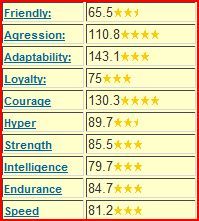 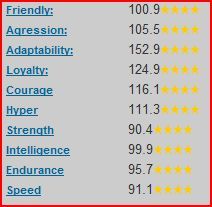 One of the first questions a new player to
Virtual Pups will ask is inevitably: “What are stars, and how can I get
them?” It is rather simple after one has noticed one key thing: On
every dog’s page there is a yellow star beside each stat. The more
stats that have 4 stars in the stat the more the dog is worth. The
number of stats with 4 stars is written with the number followed by x4.
So dog on the left stats would be 2x4, two stats with four stars, while
the dog on the right would be a 10x4. One of the first questions a new player to
Virtual Pups will ask is inevitably: “What are stars, and how can I get
them?” It is rather simple after one has noticed one key thing: On
every dog’s page there is a yellow star beside each stat. The more
stats that have 4 stars in the stat the more the dog is worth. The
number of stats with 4 stars is written with the number followed by x4.
So dog on the left stats would be 2x4, two stats with four stars, while
the dog on the right would be a 10x4.
The maximum is a 10x4. This is because there are
only ten stats, and you may only reach four stars in any stat. A 10x4
dog may be worth millions depending on the breed. Generally the worth
of a dog increases for each star it has.
Raising the stars of
your dog is less strait forward. Breeding is the
only way to change the amount of stars your dogs will have. The number
of stars will increase or decrease depending on the training your dog
has received. All dogs also have numbers in between the stat title and
stars. Training your dog will increase this number. Any number over 100
will produce pups with more stars than the parents, while any number
below 100 will cause a decrease in the number of stars. The more a
number increases over 100 the larger the chance that pups will gain
that extra star or three.
There are three main
ways that players will attempt to advance quickly.
By far the most popular is to have a sponsor trainer groom the dog
until 11 years of age. In a sponsor trainer’s account grooming will
raise every stat except for the aggression stat. However, this training
is often costly and time consuming, thus some players only groom until
all the stats are at least 200. This less intensive grooming may lose a
star, but you’ll still have a few years to event the dog. The third
training consist of rough housing (Or called RH) with the dog. This
will raise all of the stats at the same time, however only three rough
housing trainings can be made during a turn. This often ages the dog to
quickly for most. Also the aggression stat will cap at 250. Having been
on Virtual Pups for a few years now, I find that a combination of the
training is more useful in raising those stars.
CLICK IMAGE TO ENLARGE
The stubborn star refers to the hyper stat. Many
players have hit the wall on this one. The hyper stat is your nemesis
if you are attempting a 10x4 dog. Now some breeds do not have this
problem, however, the majority do. If you find that you have hit the
wall there is may be that your dog has the ‘hyper glitch’ it may have
inherited this from the imports, the way to check this is to see if
they were imported around the number 500000 (this number is only an
estimate). If not well, you’ll just have to keep training the tar out
of them until a 10x4 is born.
With determination, training and breeding, your dogs can become stars
across the board.
|
 BY JNFERRIGNO
BY JNFERRIGNO
You have heard the
story before - how the Darley
Arabian, Byerly Turk, and Godolphin Arabian founded the Thoroughbred
breed - but what has become of the culture that gave us these horses?
To answer that, it is first important to understand how these cultures
came about.
It is not known
precisely where the domesticated horse originated,
however, one of the oldest Babylonian myths tells a tale where horse
and human sprung forth together, and explains this symbiotic
relationship between man and beast in the years to come.
For over 3,500 years,
the breeders whom contributed to the horse,
were as celebrated as the horse itself. Historians cannot seem to agree
on who was the first to refine the horse, however that seems to matter
little when it is taken into account everyone who has left their mark
on history.
The Bedouin are
desert-dwelling nomads of Arabia, the Negev, and
the Sinai. This tribal culture is organized on several hierarchy
levels, which primarily revolved around family and similar interests.
It is due to these interests that the Bedu horse breeders gathered and
generally accepted one another, sharing their secrets and passions for
their livelihood. At times of large gatherings, such as Ramadan, these
tribes set aside their tribal disputes and celebrate the Arabian horse
through show and racing.
The Bedouin would race
their finest horses, and the winner would
get to choose the best from each tribe's herd. For those that could not
access the secrets of other bloodlines, this was the next best way. In
these tribes, a person's value was measured in horses, and Arabian
horses were therefore given the best and most royal respect. They were
allowed to sleep in the same tents at their masters and mistresses, as
well as eating from the same bowl. In this way, the Arabian horse
became a healer of nations, and would later seal the pact through the
birth of a foal from one nation's stallion, to the other's mare.
Islamic rule reigned
for a hundred more years, spreading east and
west, until being defeated in the mid 700s A.D. As a result, the
Arabian horse traveled out of Arabia and eventually into the rest of
the world. The Crusades brought back Arabian bloodstock to England and
France, however, one unfortunate downfall was that all horses which
came from the middle east and Africa were called Arabians. This caused
for a number of misconceptions, and only recently, through genetic
testing, are we able to delve further into history.
One breed of horse this
new development has help to correct, is
the Godolphin Arabian. Evidence suggests this horse should be called
the Godolphin Barb, and is believed to originate from Northern Africa.
Generally countries residing in North Africa are included in the
definition of the Middle East, since both reigns make up the Arab
world. And the Maghreb, which covers a the largest area of Northern
Africa, just so happens to be known for its great horse culture.
|
These days throughout
Morocco, the Fantasia is preformed during
cultural festivals. In Maghreb, it is more traditionally known as the
Game of Gunpowder, and is used to close a berber wedding celebration. This equestrian performance consists of a group of
horse back riders,
decorated in traditional cloths and tack, charging in a single straight
line at the same speed. Think of it as the Moroccan equivalent to drill
team. At the end of this synchronized act, the riders fire their guns
all at once into the air so that only a single shot is heard. The Barb
horse used for this event is specially bred, and is known as a fantasia
horse. This modern display was actually the result of inspirational and
historic wars between the Berber and other desert tribes of Northern
Africa. Now days, it’s considered a cultural art, and symbolizes the
strength of a bond between horse and rider.
Unfortunately modern
improvements have halted, and in some cases
reversed, this pastoral culture from flourishing. The Bedu, and other
subtribal groupings in Africa have had to face change in favor of a
more opportunistic system. Trucks for instance, make transporting
animals and water much easier, and telecommunications are now used to
check the availability of limited pasture land. Available land is
limited now due to the closing of national boarders and breakdown of a
traditional authority system. What rangeland left is often used for
intensive cultivation, and natural forage is completely gone in many
areas now.
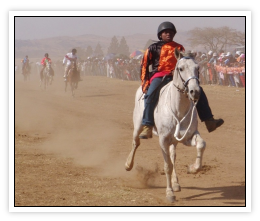
Thank
you to the Moroccan National Tourist Office and Sport and Recreation
South Africa for the wonderful photos.
|
 BY
JADE1
BY
JADE1
Many of you have had the privilege of knowing
Missing, who was voted August's player of the month. She is one of
VHR’s veteran players, having been playing VHR for the past five years.
Some of you have said that Missing is lucky being able to live out her
dreams surrounded by the horses that she loves. This month we are going
to find out a little more about her interesting personal life.
Her family has owned
horses for decades, so she has pretty much grown
up around them. “Riding was just something my family did.” she tells
me. Missing learned everything that she knows about horses from her
mother, from learning to ride to learning how to train. She originally
began her riding career learning how to ride English, with her focus
mostly being on dressage and cross country. With her mother’s
encouragement, she had the confidence to branch out as a young teen and
start learning to ride western. “At our place in Roland, Arkansas, we
bred and trained thoroughbreds or part thoroughbred jumpers, dressage
horses, and barrel horses.” adding that her family also owned two race
horses. Her mother is the one who really inspired her to do whatever
she wanted to do in her life and to do it because it was what she
wanted and not what someone else wanted. Sadly, Missing lost her mother
who had always been her greatest inspiration to breast and lung cancer
in 2006.
Missing has recently
moved and has begun to work on making her dreams
of operating a successful ranch become reality. “I really hope that I
can make a name for my ranch (Broken Pattern Ranch in Hot Springs
Arkansas) and be known for breeding and training reining horses” she
says. Having just recently gotten her barn finished, she has begun
taking on horses to train for others in addition to her own horses. She
would be happy to be known on the local level but adds that it would be
nice to attend a national or regional show or two if her horses turn
out to be of that caliber. In the future, she hopes to build her own
stock of foundation based Appaloosas that have ideal conformation and
temperament, which are suited for reining and cow work. Her remuda
currently consists of one stallion that has not covered any mares yet,
but she hopes to use him next year for breeding and twelve broodmares.
Her halter mare recently gave birth to a foal in June.
The foundation
Appaloosa’s temperament and that they are known to be
spitfires were the attributes that first attracted Missing. Their
hardheadedness and stubborn attitudes provide her with a challenge that
she is happy to take on. She believes that Appaloosas are a beautiful
breed and wonders who can deny that their patterns are striking in most
instances. In addition to the Appaloosa horses, she also has a part
bred Paint gelding, a Thoroughbred gelding, and a little Quarter Horse
mare. She says that most of them spend the year living on forty acres
of pasture twenty four hours a day, seven days a week. She adds that
her horses enjoy chasing the turkeys which are abundant where she
lives. 
A couple of friends
help her with the horses if she has something major
going on such as a vet or farrier visit. They also accompany her to
horse shows when she also allows that she is known to lose her cool if
she doesn’t have someone to tell her to sit down and chill out for a
minute. Her boyfriend also helps her with daily chores like feeding and
maintenance around the ranch. Missing’s three year old daughter really
loves horses and enjoys helping her mother with feeding and grooming
the horses. With day to day training and riding she is on her own, but
adds that she wouldn’t be able to do what she loves without the help of
friends and family.
Her paint gelding Di is
absolutely her favorite horse. Missing
purchased Di at an auction when she was thirteen years old. She says
that he was big, and pretty, but still pretty wild when she bought him,
but with her mother’s help he quickly became her favorite horse to
ride. She says that “Di has a huge personality and is a great horse”.
Now that Di is twenty years old, Missing rarely rides him anymore. She
says that she still loves him very much, adding that he has taken her
through a lot in the eleven years that she has owned him. Before his
retirement Di pretty much did everything including jumping, cross
country, reining, cattle work and anything else that she asked of him.
These days, she is
eagerly awaiting the circuit finals in reining
in which her three year old stallion, Arkansas Cherokee Storm,
qualified for this year. The circuit finals will be held in October.
They have attended eight shows over the summer and she is very proud of
her horse, who has managed to acquire twelve ApHC points in his very
first show season. I know that all of Missing’s friends on VHR wish
both her and her horse the best at their upcoming show.
|
|
|

BY
TONYS_BELLA
|
|
"On the shores of the
Caspian Sea in Northern
Iran there exists a breed of small pony which I have never seen
described in books, and which is practically unknown outside its own
territory" -- Louise Firouz, 1965
They are living ancestors of
the horses we adore today. King Darius
used them to pull his chariots during public lion fights. King Ardashir
can be seen on a rock relief, from 224 AD, in the palace of Persepolis,
mounted on a horse so small his feet almost touch the ground. Once
prized by Persian royalty as pets, chariot steeds and mounts, they
seemingly faded from existence during the battle of Qadisiya in 637 AD.
They have been called the prototype Arabian.
Lydian, Moulecki, Pouseki,
Pumpelli, all are ancient names for a horse
so small it never grows past 12 hands
|
high. With a refined build
reminiscent of an Arabian and a thick,
luxuriant mane and tail, this
horse also exhibits traits not found in any other breed of horse. An
extra molar; pronounced elevation of the interparietal bones and no
parietal crest; a wider scapula than normal; metacarpal and metatarsal
bones which are much longer and slimmer in relation to size; narrow,
oval-shaped hooves with a frog that is less pronounced than in other
equines; and the first six vertebrae being longer than usual. This
horse is also known for its exceptional movement with long strides
allowing it to easily keep up with horses much larger than itself.
This diminutive horse
is the closest living descendant of what
scientist often refer to as horse type four, the Tarpan or Mesopotamian
horse. A living predecessor to many of the hot-blooded breeds of today,
most notably the Arabian. Genetic testing is currently underway
to prove this beyond a shadow of a
doubt. Thought long gone from the
Earth, this equine was rediscovered in 1965 by Louise Firouz, when she
decided to open a riding school for children in Iran. She dubbed it the
Caspian Horse. While sometimes referred to as a pony the Caspian is
indeed a horse and not a pony at all.
At the time of Firouz’s
rediscovery, there were less than thirty
Caspians still alive. She captured several of them, seven mares and six
stallions, and returned to her riding school, using them as riding
horses for children. She found them very kind, quite gentle and
extremely intelligent. The breed proved to be fast learners willing to
do anything asked of them.
Striving to save the
breed from extinction, Firouz began capturing and
breeding only the purest Caspians she could find. The first founding
stud of her breeding
|
program was Ostad, who
was once used as a cart
horse. However, her breeding program was impeded by the revolutionary
war, her horses were confiscated and most of those running wild were
captured for use as pack horses or food. She did, however, manage to
get several of the horses out of the country to England and the United
States. Breeding programs were started in these countries and after the
war, Firouz managed to export 15 more Caspians for breeding. One of the first studs exported was Jehan*, purchased
by Kathleen
McCormick. The four day journey that brought Jehan* to the United
States, proved to be so difficult only a part-bred program could be
started in the US until years later, after the end of the revolutionary
war and the export of more Caspians to England. Today the breed exists
in several European countries and the United States albeit in small
numbers and is currently listed by the American Livestock Breeds
Conservancy as a “Critical Rare Breed”. There are believed to be less
than 2,000 Caspians in the world right now.
Louise Firouz
maintained her own herd in Amol, Iran until her husband’s
death in 1994. The last horses of her herd there were sold to The
Ministry of Jehad. After her husband’s death, she moved to the Turkoman
Steppes and began a new herd, which she kept and improved until her
death earlier this year.
Flame of fire, storm grey, sable earth, black of night, the hardy
Caspian comes in chestnut, grey, bay and black, though grey specimens
can go through many stages of roaning before going completely grey. It
is used today primarily as a child’s or small adult’s mount and excels
in jumping and harness work. The Caspian also makes a suburb show horse. |
|
|
 |

|
|



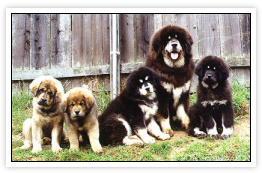

 Their size makes living
together and foraging together a natural
defense against their predators, which can be many and come from all
points. The Martial Eagle, with a wing span of six foot, and other
birds of prey attack from the sky. Primary defense from these would be
diners is the meerkat’s outstanding vision and the habit of posting
sentries. With dark bands around their eyes, they can look directly
into the sun and see a bird. From the ground, the meerkat must watch
for predatory cats and Jackals. However, against these land bound foes,
the meerkats have learned to put their fighting techniques to another
use. It has been known for a gang of meerkats to mob a jackal, chasing
this predator, that can be three times their size, away. This strategy
is also used against the poisonous snakes that inhabit their home turf
and attempt to prey on them and their young. They don’t try to kill
their attackers only confuse them to the point of giving up and going
away. They always leave an avenue of escape and use all their grit and
guts to feign attack from every other side.
Their size makes living
together and foraging together a natural
defense against their predators, which can be many and come from all
points. The Martial Eagle, with a wing span of six foot, and other
birds of prey attack from the sky. Primary defense from these would be
diners is the meerkat’s outstanding vision and the habit of posting
sentries. With dark bands around their eyes, they can look directly
into the sun and see a bird. From the ground, the meerkat must watch
for predatory cats and Jackals. However, against these land bound foes,
the meerkats have learned to put their fighting techniques to another
use. It has been known for a gang of meerkats to mob a jackal, chasing
this predator, that can be three times their size, away. This strategy
is also used against the poisonous snakes that inhabit their home turf
and attempt to prey on them and their young. They don’t try to kill
their attackers only confuse them to the point of giving up and going
away. They always leave an avenue of escape and use all their grit and
guts to feign attack from every other side. 

